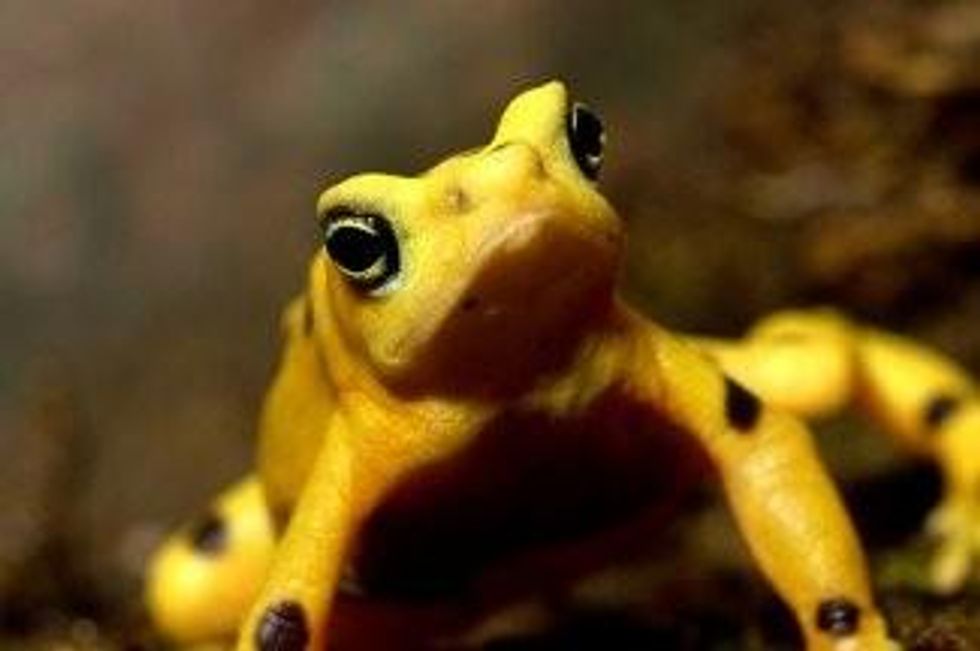If the current rapid extermination of animals, plants and other species really is the "sixth mass extinction", then it is the amphibian branch of the tree of life that is undergoing the most drastic pruning.
In research described as "terrifying" by an independent expert, scientists predict the future for frogs, toads, newts and salamanders is even more bleak than conservationists had realised.
Around half of amphibian species are in decline, while a third are already threatened with extinction. But scientists now predict that areas with the highest diversity of amphibian species will be under the most intense threat in the future.
And they warn that a three-pronged threat could also cause populations to decline faster than previously thought.
Like many creatures, amphibians have been hit hard by climate change and habitat loss. But they have also been decimated by the spread of the deadly fungal disease chytridiomycosis.
One in three of the world's amphibians are on the International Union for Conservation of Nature's red list of endangered species. These include the Malagasy rainbow frog that lives in the rocky forests of Madagascar. It has the ability to inflate itself when under attack and can climb vertical rock faces. Found in an area smaller than 100 square kilometres, it is a prime target for the pet trade.
The Chinese giant salamander is also critically endangered. The largest of all amphibian species, it can grow to more than a metre long. Overexploitation for food has led to a catastrophic decline in the last 30 years.
European species are also threatened. Scientists predict climate change, habitat destruction and disease could drive more than half of all Europe's frogs, toads and newts to extinction within 40 years.
Now the largest study of its kind has found that it is in areas where amphibian diversity is at its highest that the greatest threat lies.
Researchers led by Dr Christian Hof, from the University of Copenhagen, used computer modelling to predict the impact of climate change, the effect of habitat loss from urbanisation and farming and, finally, the fungal disease on amphibian populations.
"What we found looking at climate change, for example, is that many tropical regions, such as northern South America, the Andes and parts of Africa, will be highly impacted," said Hof. The team then compared this map of impact with the global distribution of more than 5,500 species of amphibians.
The results, published in the Journal Nature, show that two-thirds of the areas with the richest diversity of frog and salamander species will be affected by one or more of these threats by 2080.
Scientists also found that some of the threats overlapped.
The regions where amphibian populations are expected to suffer most from climate change tended to overlap with the areas that could suffer most from habitat destruction. The fungal disease, on the other hand, was more isolated.
"What we still have not really understood is the mechanistic interaction between them, like how does land use change or the fragmentation of habitats influence the potential responses of a species to climate change," said Hof.
Overlapping threats could mean that estimates of the rate of amphibian decline are too optimistic and that populations could decline even faster than previously thought.
Helen Meredith, amphibian conservationist at the Zoological Society of London, said: "Looking into 2080, it seems there will be more extinctions of species of amphibians, which is terrifying as a third of all amphibian species are threatened with extinction now.
"Data is deficient for a quarter of them, which means we don't know whether they are threatened with extinction or not and about half of all amphibian populations are in decline. And that is just what is happening at the moment."
Fighting for life
Kihansi spray toad Nectophrynoides asperginis
Less than 2cm long, this toad is adapted to living in the spray of the Kihansi and Mhalala waterfalls in the Udzungwa mountains of Tanzania.
Anderson's salamander Ambystoma andersoni
Found in one lake in Mexico, it is critically endangered. The species is unusual because it is neotenous: it never develops into an adult.
The Panamanian golden frog Atelopus zeteki
Four-fifths of the species has been wiped out by the Chytrid fungus. Extinct in the wild.
Lehmann's poison frog Dendrobates lehmanni
This toxic species lives in the Colombian rainforest. Habitat destruction for logging and agriculture has left it critically endangered.



